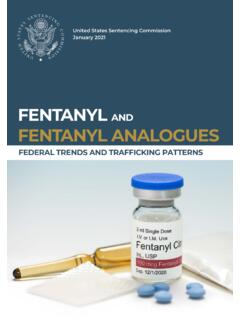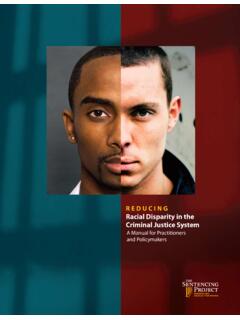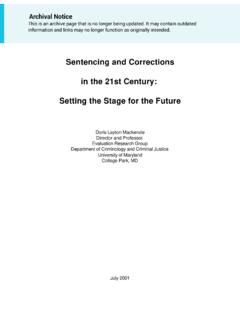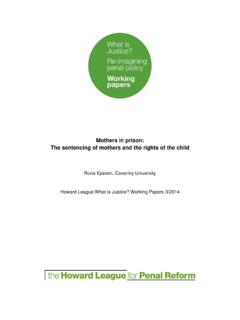Transcription of Critical Criminal Justice Issues - Office of Justice Programs
1 Task Force ReportsFrom the American Society of Criminologyto Attorney General Janet RenoCritical CriminalJustice Department of JusticeOffice of Justice ProgramsNational Institute of JusticeCritical CriminalJustice IssuesTask Force ReportsFrom the American Society of Criminologyto Attorney General Janet RenoFOREWORDT here is a discernible urgency to the crime issue . Crime and the fear of crime rank as the most important Issues inpublic opinion polls. Some communities resemble war zones where gunshots ring out every night. Other citiesstruggle to create islands of civility amid threats to public order posed by low-level Criminal behavior that eludestraditional , public policymakers and administrators in the Criminal Justice system are responding to the issue ofcrime in all its complexity. Every aspect of the infrastructure of our traditional Criminal Justice policy is undergo-ing fundamental rethinking. Our approaches to policing, adjudication, sentencing, imprisonment, and communitycorrections are changing in significant ways.
2 Indeed, communities that are suffering from crime are changing theirinteractions with the agencies of the Criminal Justice system as the concepts of community policing, communityprosecution, and community Justice take on real meaning in cities and towns around the combination a sense of urgency on the part of the public and a rapidly changing policy response creates acompelling need for policy-relevant research. When Attorney General Janet Reno addressed the American Societyof Criminology at its annual meeting in November 1994, she challenged Society members to translate their re-search findings into recommendations that would benefit the practitioners and policymakers who confront theissues of crime and reports presented in these pages are the response to that challenge. The Society established 12 task forces indifferent areas of research activity and asked the task force members to distill their research findings into policyrecommendations that would advance the important public debate now under way in the Nation.
3 In this regard,the members of the Society have performed a valuable public service. We thank Dr. Freda Adler, then-president ofthe Society, and the Society s members for this remarkable contribution to improving our understanding of theissues of crime and the challenge of TravisDirectorNational Institute of JusticeiCritical CriminalJustice IssuesTask Force ReportsFrom the American Society of CriminologyiiNCJ 158837iiiTABLE OF CONTENTSF oreword .. Inside Front CoverPreface .. vEarly Prevention of and Intervention for Delinquency and Related Problem Behavior .. 1 Youth Violence .. 13A New Vision for Inner-City Schools .. 23 Drug Policy Options: Lessons From Three Epidemics .. 33 Drugs and the Community .. 47 Violence Against Women: Overview .. 61 Domestic and International Organized Crime .. 73 Designing Out Crime .. 85 The State of the Police .. 95A Crime Control Rationale for Reinvesting in Community Corrections .. 105 Three-Strikes Legislation: Prevalence and Definitions.
4 121 American Crime Problems From a Global Perspective .. 135vPREFACEAt the 1994 American Society of Criminology (ASC) annual meeting, Attorney General Janet Reno appealed tothe assembled scholars of criminology for their urgent assistance in dealing with some of the major crime andcriminal Justice Issues facing the Nation and, hence, the Administration. Her address to the ASC identified 12such the day following her appeal to us, the ASC National Policy Committee met and formed 12 correspondingtask forces. The chairs of these task forces had to find their expert collaborators within the shortest span of a matter of a few months, the task forces had completed their reports, and they were submitted to AttorneyGeneral my submission I made it clear that:1. The reports were those of groups of individual ASC members. They do not represent any official positionof the The Attorney General did not ask us for heavily documented research papers, but rather for the essence ofknowledge on the various The reports cover agreements and controversies on each of these Issues , be they supportive or not of currentlyexisting governmental policies or Attorney General read the reports with the greatest attention, convened a meeting of task force chairs at heroffice, and probed a variety of findings (and policy implications) with the greatest care.
5 In her concluding remarksshe expressed her gratitude to the task forces and her great satisfaction with our willingness to respond so quickly,so thoroughly, and so helpfully. Many of the findings have already found their way into the policymaking process;others are likely to follow the same Attorney General also noted with great interest that our recent questionnaire distributed to our entire mem-bership revealed that a large number of our members are engaged in policy-relevant research and are willing tocontribute to the policymaking process. (She asked for a followup report on the ASC Survey of Members Research.)This volume includes summaries as well as the text of all 12 task force reports. The summaries were prepared byAspen Systems Corporation, under the direction of the National Institute of Justice . My thanks go to Aspen forsuperbly summarizing the wish to extend my thanks to all members who so willingly devoted their time and effort pro bono to thisunprecedented service for the cause of enlightened, humane, and effective Criminal Justice policy.
6 My gratitudealso goes to Attorney General Reno for offering us the opportunity to AdlerPresident, 1994 1995 American Society of CriminologyviiFOREWORDT here is a discernible urgency to the crime issue . Crime and the fear of crime rank as the most important Issues inpublic opinion polls. Some communities resemble war zones where gunshots ring out every night. Other citiesstruggle to create islands of civility amid threats to public order posed by low-level Criminal behavior that eludestraditional , public policymakers and administrators in the Criminal Justice system are responding to the issue ofcrime in all its complexity. Every aspect of the infrastructure of our traditional Criminal Justice policy is undergo-ing fundamental rethinking. Our approaches to policing, adjudication, sentencing, imprisonment, and communitycorrections are changing in significant ways. Indeed, communities that are suffering from crime are changing theirinteractions with the agencies of the Criminal Justice system as the concepts of community policing, communityprosecution, and community Justice take on real meaning in cities and towns around the combination a sense of urgency on the part of the public and a rapidly changing policy response creates acompelling need for policy-relevant research.
7 When Attorney General Janet Reno addressed the American Societyof Criminology at its annual meeting in November 1994, she challenged Society members to translate their re-search findings into recommendations that would benefit the practitioners and policymakers who confront theissues of crime and reports presented in these pages are the response to that challenge. The Society established 12 task forces indifferent areas of research activity and asked the task force members to distill their research findings into policyrecommendations that would advance the important public debate now under way in the Nation. In this regard,the members of the Society have performed a valuable public service. We thank Dr. Freda Adler, President of theSociety, and the Society s members for this remarkable contribution to improving our understanding of the issuesof crime and the challenge of TravisDirectorNational Institute of Justice1 Critical Criminal Justice ISSUESE arly Prevention ofand Intervention forDelinquency andRelated ProblemBehaviorMarcia Chaiken, LINC, Co-chairDavid Huizinga, University of Colorado, Co-chair3 Critical Criminal Justice ISSUESI ssuesStrong evidence linksearly problem behaviorto later adolescent de-linquency and seriousadult children in theUnited States are lack-ing fundamental ele-ments essential forhuman children are legally entitled, buthave no access, to safe shelter, adequate food, basichealth care, and sufficient preparation to becomeeconomically viable adults.
8 The absence of theseresources has been linked to abnormal develop-ment, economically and socially marginal exist-ence, and persistent whose parents are criminals have a highprobability of becoming delinquents. Those identi-fied in court as abused or neglected by their parentsare more likely than other children to become de-linquent. Offenders whose parents were also crimi-nals have a high probability of being high-ratepredatory criminals. However, whether or not theirparents have Criminal histories, children raised bymothers or fathers with good parenting skills areless likely to become delinquents or serious offend-ers. Inmates who assume responsible family rolesafter they are released are less likely to recidivatethan offenders without family ties. The vast major-ity of delinquents and criminals eventually matureout of crime; assumption of family responsibilitiescan be a key factor in this documents the effectiveness of early pre-vention and intervention in forestalling these out-comes.
9 Waiting until the mid-to-late teenage yearsto intervene in persistent delinquency ensures thatthe battle will be difficult, if not impossible. Thecurrent focus on older juveniles is at best a stopgapmeasure; it ignores younger children, who, in theabsence of early prevention/intervention, will soonfollow the same non-productive path astheir teenage rolemodels. Research alsosuggests that earlychildhood programscost relatively littlecompared to the costsassociated with theproblems they preventlater, such as drug andalcohol abuse, teen pregnancy, specialeducation requirements, or early childhood Programs when com-pared to less successful ones most often have thesecharacteristics:nThey attempt to ameliorate more than one ortwo factors associated with delinquency andfocus on multiple problem are designed to be appropriate for childrenof specific ages and at specific stages involve long-term efforts of more than afew months, often lasting several on the above and other current research, thetask force policy recommendations focus on howthe Department of Justice can assist with earlyprevention and recommendationsnEarly prevention.
10 The Department of Jus-tice should take a leading role in the interagencydevelopment of early prevention efforts thathave shown evidence of being effective, inparticular:q Establishment of home visitation programsfor mothers at high risk for abusing, neglect-ing, or inadequately providing for the needsof their PREVENTION OFAND INTERVENTIONFOR DELINQUENCYAND RELATEDPROBLEM BEHAVIOR4 Critical Criminal Justice ISSUESq Establishment of educational daycare pro-grams with a home visitation component forat-risk infants and children that provide assis-tance to parents, teach parenting skills, andinvolve marital and family facto, as well as de jure, provision ofservices to which children and adolescents arelegally entitled, especially services essentialto their safety and wholesome development( , development of neighborhood-basedcollaborative community development andyouth development Programs that emphasizeprovision of basic needs for infants and pre-school children and actively recruit and sus-tain participation of older children in thenonschool hours).














